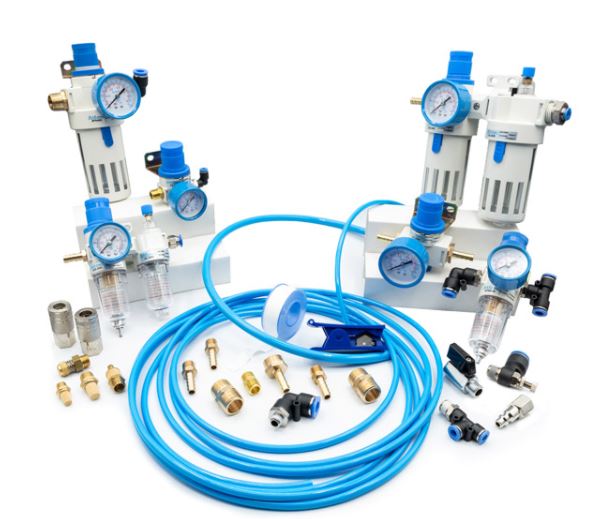Power measurement and comprehension are important for a wide range of industrial applications in the dynamic and ever-evolving field of pneumatics. The efficiency, dependability, and safety of these systems — from production lines to automated machinery — are significantly influenced by their power capacities.
This blog explores the several techniques used to assess and gauge the power of pneumatic systems. For anybody with a strong interest in pneumatic technology, be it engineers, technicians, or others, this blog will offer an invaluable understanding of the complexities of pneumatic power measurement and its importance in the contemporary industry.
In-Depth Understanding of Pneumatic Power
Pneumatic power, a cornerstone in various industrial and manufacturing processes, operates on the principles of air pressure and flow dynamics within the system. The essence of pneumatic power lies in its ability to convert the energy stored in compressed air into mechanical work, making it a versatile and efficient power source.
To maintain this efficiency, proper upkeep, encompassing regular checks and precise calibrations, is imperative. This maintenance not only ensures the system operates at peak performance but also significantly prolongs its operational lifespan. Moreover, regular maintenance can help in identifying potential issues early, preventing costly downtime and ensuring the safety of the operating environment.
Measurement and Evaluation Techniques
Several techniques are essential for measuring pneumatic power effectively:
- Pressure Gauges: Integral to any pneumatic system, pressure gauges provide real-time data on the system's air pressure, a critical determinant of its overall performance. By enabling regular monitoring, these gauges ensure that the pneumatic systems operate within safe and efficient pressure parameters, thereby safeguarding against potential malfunctions due to pressure imbalances.
- Flow Meters: These tools are indispensable in quantifying the rate of airflow through the system, an essential metric in assessing the system’s ability to handle specific tasks. Accurate flow measurements help in fine-tuning the system for optimal performance, especially in applications where precise airflow control is crucial.
- Dynamometers: Particularly useful in complex and high-powered pneumatic systems, dynamometers are employed to measure the mechanical power output. They provide valuable insights into the system's efficiency and capability under varying operational conditions, enabling a more nuanced understanding of its performance characteristics.
- Analytical Software: In modern pneumatics, advanced software tools play a crucial role in simulating various operational scenarios. These simulations are instrumental in optimizing both system performance and maintenance strategies, allowing for predictive maintenance and system enhancements based on data-driven insights.
Industrial Applications and Fittings
Pneumatic systems serve a broad range of industrial applications, each requiring specific types of pneumatic fittings to ensure secure and efficient operation:
- Manufacturing: Here, pneumatic systems power various machinery, where the choice of fittings, such as durable brass fittings, is essential for ensuring leak-free operation and system integrity.
- Automotive Industry: The use of pneumatic tools for repair and assembly relies heavily on the quality and compatibility of pneumatic fittings to ensure tools operate effectively.
- Material Handling: The smooth operation of pneumatic systems in material handling is greatly influenced by the type and quality of fittings used, with brass fittings often preferred for their durability and corrosion resistance.
- Medical Field: Precision and reliability are key in the medical field, where the correct fittings ensure that pneumatic systems operate safely and efficiently.
Emphasizing Efficiency and Safety
Efficiency in pneumatic systems goes hand in hand with their safety and reliability, heavily reliant on consistent maintenance and the utilization of suitable fittings and components. Regular inspections and maintenance ensure these systems are operating at their peak, reducing the risk of energy loss and improving overall productivity.
Moreover, attention to detail in maintaining these systems, especially ensuring they are free from leaks and properly calibrated, is paramount for safety. Leak-free and well-calibrated pneumatic systems not only perform more efficiently but also significantly reduce the risk of accidents and malfunctions, thereby safeguarding both the equipment and the personnel involved. Hence, efficiency and safety in pneumatic systems are interdependent, with each aspect reinforcing the other to create a robust and reliable system.
Future Trends in Pneumatic Systems
Technological advancements are expected further to enhance the efficiency and scope of pneumatic systems. Innovations in fittings, materials, and system design will play a significant role in these advancements, driving more efficient, reliable, and versatile pneumatic solutions.
Evaluating and measuring the power of pneumatic systems is vital for maximizing their efficiency and effectiveness across various industries. The role of maintaining pneumatic systems, along with the importance of using the right pneumatic fittings cannot be overstated. These elements are crucial in ensuring that pneumatic systems remain reliable and efficient in the industrial world.

